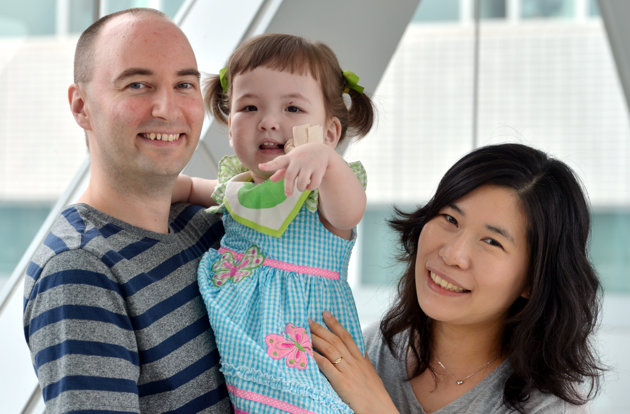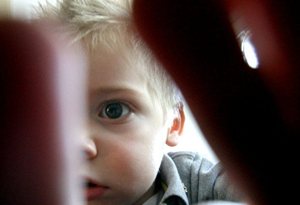In This Issue
|

Hannah Warren, 2, poses with her parents Lee Young-mi and Darryl Warren at Seoul National University Hospital in Seoul, South Korea. Hannah received a new windpipe made from her own stem cells in a landmark operation on April 9, 2013, at Children's Hospital of Illinois in Peoria, Il.
Real People...Real Treatments
Repair Stem Cells is the greatest medicine ever laid at the feet of mankind
The Repair Stem Cell Institute's mission is to bring this absolute truth to an unbelieving world.
|
Ghost Heart, a framework for growing new human hearts (and other body parts) with Adult Stem Cells
Press Play to view this exciting Video from PBSThe problem: More than 3,200 people are on the waiting list for a heart transplant in the United States. Some won't survive the wait. Last year, 340 died before a new heart was found.
The solution: Take a pig heart, soak it in an ingredient commonly found in shampoo and wash away the cells until you're left with a protein scaffold that is to a heart what two-by-four framing is to a house.
Then inject that ghost heart, as it's called, with hundreds of millions of blood or bone-marrow stem cells from a person who needs a heart transplant, place it in a bioreactor -- a box with artificial lungs and tubes that pump oxygen and blood into it -- and wait as the ghost heart begins to mature into a new, beating human heart.
Doris Taylor, Director of regenerative medicine research at the Texas Heart Institute at St. Luke's Episcopal Hospital in Houston, has been working on this -- first using rat hearts, then pig hearts and human hearts -- for years. She has grown rat and pig hearts, but not human hearts -- yet. That's her goal.
Press the "Full Story" link below to see PBS' exciting video
illustrating the process of growing new body parts.
It's most likely years off, but it's a pretty sure bet it will happen.
Researchers believe the human hearts, just like the animal ones, won't be rejected because they'll be custom-made using the recipient's stem cells. That means future transplant patients won't have to take anti-rejection medication and won't have to put up with the side effects that accompany those drugs: an increased risk of high blood pressure, diabetes and kidney failure. They won't have to undergo dozens of heart biopsies. And they won't have to worry about the pain, time and expense of a second transplant.
"And the nice thing about this technology," Taylor says, "is that it will work with any organ or tissue. So it's not just about hearts." Kidneys, livers, lungs, pancreases, they'll be growing those, too.
2-year-old girl gets windpipe made from stem cells
CHICAGO (AP) — Hannah Warren has been unable to breathe, eat, drink or swallow on her own since she was born in South Korea in 2010. Until the operation at a central Illinois hospital, she had spent her entire life in a hospital in Seoul. Doctors there told her parents there was no hope and they expected her to die.
The stem cells came from Hannah's bone marrow, extracted with a special needle inserted into her hip bone. They were seeded in a lab onto a plastic scaffold, where it took less than a week for them to multiply and create a new windpipe.
About the size of a 3-inch tube of penne pasta, it was implanted April 9 in a nine-hour procedure.
Early signs indicate the windpipe is working, Hannah's doctors announced Tuesday, although she is still on a ventilator. They believe she will eventually be able to live at home and lead a normal life.
"We feel like she's reborn," said Hannah's father, Darryl Warren.
"They hope that she can do everything that a normal child can do but it's going to take time. This is a brand new road that all of us are on," he said in a telephone interview. "This is her only chance but she's got a fantastic one and an unbelievable one."
Dutch Stem Cell Transplant Patient overcomes Leukemia to win Olympic Gold Medal in Marathon Swimming
-width=300&height=367.jpg)
After a stem cell transplant, Van der Meijden gradually recovered and made a comeback at the 2003 and 2004 Open Water World Championships where he swam faster than before the disease.
Starting swimming at age seven, Maarten Van der Meijden was regarded as a great swimming talent. He took part at the European Youth Championships in 1999 and the Open Water World Championships in 2000.
But his swimming career seemed to have to come to a sudden end in 2001 after being diagnosed with leukemia.
After a stem cell transplant, Van der Meijden gradually recovered and made a comeback at the 2003 and 2004 Open Water World Championships where he swam faster than before the disease. In the 2008 World Championships, he won a gold in the 25-km race, a bronze in the 5-km race and ranked fourth in 10-km.
Van der Meijden said his past disease has taught him well in swimming. "It taught me to think step by step and to be patient. When you are in so much pain and lying in a hospital bed, you aren't thinking about the next month, but the next hour. This is the same strategy I used here -- staying in the pack and waiting for my chance."
The Dutch swimmer also thanked people who contributed to the cancer research. "Seven-and-a-half years ago I was fighting leukemia. Because of the stem cell transplant I got I had the luck to recover. So everyone who has donated money (to cancer research) in the past I am grateful for, as maybe I wouldn't be here otherwise."
Vatican gets behind adult stem cell research
VATICAN CITY — Wading into one of the most controversial fields of modern medicine, the Vatican is pushing adult stem cell research as ethical and scientifically more promising than embryonic stem cell research.
Harvesting embryonic stem cells requires the destruction of fertilized embryos — which are considered nascent human life in Catholic doctrine. Adult stem cells can be safely taken from adult human beings.
A decade ago, embryonic stem cell research attracted big-name support, from Nancy Reagan to Michael J. Fox, even as it attracted strong opposition from some religious leaders and prompted tight restrictions on federally-funded research by the Bush administration.
But Smith argues adult stem cell research has been more successful; she says there are around 4,300 treatments based on adult stem cells which are now in clinical trials, and only 26 based on embryonic stem cells.
“People don’t have to choose between life and science,” said Robin Smith, CEO of New York-based NeoStem and president of its nonprofit arm, the Stem for Life Foundation.
“We want to correct the misunderstanding in public opinion on adult stem cells. People need to understand how far we are with research.”
NJ Blind boy cured with stem cell treatment

Not many parents get excited when they notice their toddler is watching television or looking at the family dog. Then again, not many parents have traveled to China seeking stem cell treatment for optic nerve hypoplasia, a congenital underdevelopment of the optic nerve.
Doctors estimated that Dougie Dillon's optic nerve was about 75 percent smaller than that of a child with normal eyesight.
“If you took a light and shined it in his face, about a foot away was the farthest you could go,” said Dougie’s mother, Nicole Dillon, of Maple Shade. Now, almost a year after the family spent 30 days in China, where Dougie received intravenous and spinal injections of stem cells taken from umbilical cord blood, Dougie, 2, is reacting to light, watching cartoons and learning his colors. The stem cells have stimulated the growth of the optic nerve, giving him limited eyesight.
|
Trust your crazy ideas!
Our hero in the scientific field of stem cells is a Professor, without whom there would not be 25,000 + human beings living with stem cell-improved lives on the planet today.
Her name is Dr. Doris Taylor. Fifteen years ago she challenged standard cardiology’s untouchable science by proving that heart tissue COULD be regenerated by adult stem cells. She and her Duke Univ. team showed the world what could be done and suddenly dozens of researchers set out to prove (or disprove) her animal trial.
Their results were so good that in an unheard of three year time period, they started treating humans with adult stem cells all over the world---successfully!
Excerpt by Siva Nagarajah of The UK INdependent--Creating organs for transplant is a subject matter often viewed with dubious sentiment – caught somewhere between science fiction and reality – but Dr Taylor tells me to “trust your crazy ideas”. A motto of hers from which “the decelluarlised ‘ghost’ heart was born”, in a search for radical ways to treat end-stage heart failure. “Nature has created some very complex and effective tools for repairing the human body. Endogenous repair, or the body’s ability to heal itself, is a powerful tool that we’re just starting to understand how to harness. I believe that it is possible to harness it, to optimize it and to begin to reverse disease and aging.”
In 1998 the team pioneered transplanting stem cells to patients post heart attack, leading to improved function. Reminiscing on publishing the work, Dr Taylor said “A member of the media asked me: ‘If it’s so simple, why someone hasn’t done it before?’ And what I realized was that no one had done it before because no one had believed it was possible.”
It became clear that whilst the nature of her work would be very simple, “we were never going to understand exactly how it worked”. Thus forming the philosophy “giving nature the tools and getting out of the way”, to illustrate largely how little they understood about what they were doing. But she pointed me to the example of willow bark-“hundreds of years after it was first used as an analgesic, we still don’t fully know how aspirin stops pain. That being said, we don’t have to understand every detail but…understand it enough to make it safe and effective.
Stage Four pancreatic cancer patient, given
three months to live, completes month six on
May 23: "Stronger than ever!
She forgot to die on Feb 23, which was the three months her honest oncologist in Denver gave her. He did not try to make a few extra bucks with more chemo and radiation on her oversized (7cm) inoperable pancreatic tumor plus the cancer bubbles on her liver.
When Dick & Jenny came to RSCI with the facts, just before Thanksgiving, we got into rocket-mode to get the doctor-friend who ran what we think may be the best cancer program anywhere, to approve her case. They told us her chances were about 50% at best, pending her arrival cat scan, which was a heck of a lot better than the 0% she had in America. Write info@RepairStemCells.org for treatment details.
Optic Problems?
You don't HAVE to go to China to get the miracle stem cells which brought the good life back to Dougie Dillon.
Why? The same company has opened a 21st century clinic in Thailand, and every patient we have sent there is raving about the quality and comfort of the facility. Write info@RepairStemCells.org for treatment details.
|
|